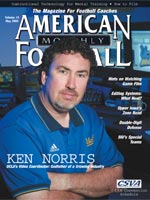Article CategoriesAFM Magazine
|
IdentitySouthern Illinois uses their kickoff teams to establish team identity© More from this issue Out
of all the special teams units at Southern Illinois University
the kickoff team may be one of the most important units to our
football program. We strongly believe the kickoff team creates
the identity and establishes the attitude of our football team.
This unit must set the tone for the game. It is critical that this
team send a message to the opponent that they will be in for a
physical contest and that we intend to win. We want players who
can run and will play with a tremendous amount of emotion and pride.
We have one goal – hold our opponent’s average field
position to the 25 yard line or less. We were number 1 in our conference
....The full article can only be seen by subscribers.
|
|
|||||||
| HOME |
MAGAZINE |
SUBSCRIBE | ONLINE COLUMNISTS | COACHING VIDEOS |
Copyright 2025, AmericanFootballMonthly.com
All Rights Reserved





